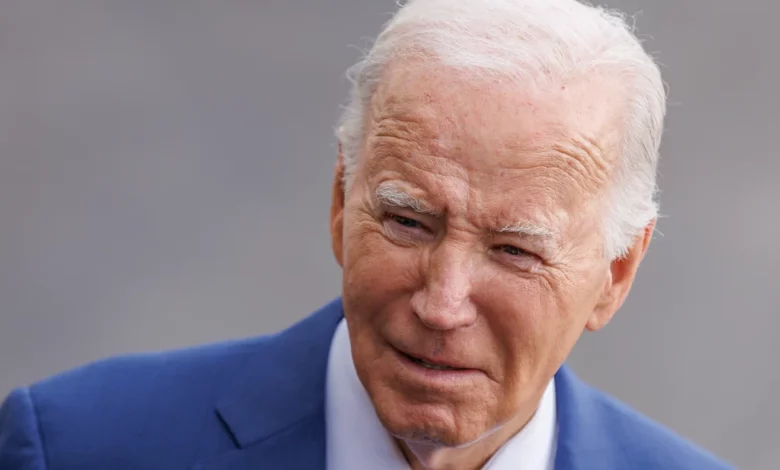
US policy in the Middle East can no longer be described as an attempt to stop the Israel-Gaza conflict from triggering a bigger regional war. That hope died weeks ago.
The critical task now for President Joe Biden — as he mulls retaliation over the deaths of three Americans in an attack by suspected Iranian proxy forces in Jordan Sunday – is to prevent that region-wide war from tipping out of control.
It is indisputable that the United States is again embroiled in a war in the wider Middle East, less than three years after Biden officially decreed the end of a two-decade-long combat mission in Iraq that exhausted the US and caused deep political trauma.
It is also clear that the Biden administration’s effort to prevent an escalation is not working. US strikes against Iranian-backed militia throughout the region, which followed more than 160 attacks on American military facilities, did not deter Sunday’s drone strike. And missile and drone attacks against commercial shipping in the Red Sea haven’t stopped despite rolling US airstrikes against their launch sites and infrastructure in Yemen.
So Biden has now arrived at the unenviable position that presidents often face when all potential options before them are bad and the very task of seeking to slow a deepening crisis may end up exacerbating it.
The catalogue of violence that has erupted outside Gaza – where tens of thousands of Palestinians have been killed after 1,200 Israelis died in Hamas terror attacks on October 7 – underscores the grave potential of the war.
— Hezbollah, a pro-Iranian group based in Lebanon, has been waging a low-grade war against Israel. On Monday alone, it said it had launched 13 attacks on targets in northern Israel. The Israel Defense Forces said that evening it carried out airstrikes on Hezbollah targets in Lebanon.
— Two months of Huthi attacks on Red Sea shipping have disrupted global supply chains and raised the cost of the cargo trade, risking a major economic impact. The US is leading a coalition of nations to protect trade.
— The US and Britain launched strikes against Huthi targets in Yemen this month and Washington has carried out multiple follow-ups. But even Biden has admitted that the strategy has not stopped Huthi attacks.
— The US also launched strikes against targets linked to Iran’s Islamic Revolutionary Guard Corps in Syria.
— The Biden administration has also carried out attacks on Iran-backed groups in Iraq, severely straining relations with the Baghdad government and raising concerns that US troops in the country to fight terrorism could be asked to leave.
— Israel expanded its own war by carrying out a drone strike that killed a senior Hamas leader in Beirut, according to US officials, fueling tensions in Lebanon – a nation beset by severe economic, political and security crises.
— Iran has blamed Israel for an attack that killed a number of Revolutionary Guard officers in Damascus, Syria.
If there is an upside to this spiraling military activity it’s that, as serious as it is, it’s unfolding as a set of controlled escalations that has yet to acquire its own destructive momentum. Some worst-case scenarios haven’t occurred — for example, a massive onslaught of missile attacks by Hezbollah against Israeli cities. The group has a far greater capacity to hurt Israel than Hamas does.
And while the weekend attack that killed the three Americans is tragic for their families and their nation, there has not so far been a large-scale attack on US interests — for instance, catastrophic damage to a US naval ship with huge loss of life — that could multiply the intensity of the conflict on multiple fronts. The calibrated escalations have fueled an impression in Washington that Iran doesn’t want a full-scale regional conflagration any more than its arch-enemy the United States does.
But if the progression of the conflict has been steady, rather than sudden, it’s not a given that it will stay that way.
“I think it’s very important to note that this is an incredibly volatile time in the Middle East,” Secretary of State Antony Blinken said Monday, before adding: “I would argue that we have not seen a situation as dangerous as the one we’re facing now across the region since at least 1973, and arguably even before that.”
Aaron David Miller, who spent years as a Middle East peace negotiator for presidents of both parties, is even less hopeful. He told CNN’s Jim Acosta on Sunday: “It’s going to get worse before it gets worse, I suspect.”
Biden’s impossible choices
As the country absorbed the loss of Sgt. William Rivers, 46, Specialist Kennedy Sanders, 24, and Specialist Breonna Moffett, 23, on Monday, Biden shared on social media a photo of him in the Situation Room after receiving a national security briefing.
He doesn’t lack for advice outside the White House. Hawkish Republicans like South Carolina Sen. Lindsey Graham are demanding he attack Iran on Iranian soil. GOP presidential candidate Nikki Haley says he should target leaders of the IRGC. Biden’s likely 2024 election foe Donald Trump is simultaneously blasting Biden as weak and accusing him of dragging the US into another Middle Eastern quagmire. The ex-president is not that different from some progressives in voicing that fear. Also on the left, however, is dismay from some at Biden’s refusal to demand a ceasefire in Gaza.
Rep. Jim Himes, the top Democrat on the House Select Committee on Intelligence, said on CNN’s “The Lead” Monday that Iran understood that there was always the risk of fatalities when its proxies attacked US bases. “A lot of us have spent time thinking what happens when there are fatalities and now we are in that world,” said the Connecticut lawmaker. “(The) response is going to be important and hopefully calibrated to send a very strong signal without increasing dramatically the odds that we get into a shooting war with Iran.”
Many politicians, experts and commentators have repeatedly speculated about the options in the last 24 hours, often citing the idea that the US needs to send a tough message but must also avoid sending the conflict into an even worse place. But one lesson from the last few months, and indeed the disastrous last 20 years of US policy in the Middle East, is that formulations and assumptions that make sense in Washington rarely play out as anyone expects in that treacherous region.
This is why Biden’s dilemma is so acute. How exactly does he find the sweet spot between deterrence and disastrous escalation? Will the reprisals he does take put US forces at even greater risk? Or will Iran just ignore them? Whenever a president takes military action, they must consider what’s next — not just how an adversary will respond immediately but in months to come and how the US is prepared to counter those reactions.
US officials told CNN’s Oren Liebermann, Natasha Bertrand and Katie Bo Lillis Monday that the American response was likely to be more powerful than previous US strikes in Iraq and Syria against Iranian interests, but they have suggested it is unlikely the US will strike within Iran. Blinken on Monday predicted the US response would be “multileveled, come in stages and be sustained over time.”
If there is one ray of light right now, it’s Monday’s news that a broad framework for a hostage release and potential ceasefire in the war in Gaza has been presented to Hamas. The emerged from proposals from Israel, Hamas, Qatar and Egypt along with additional ideas from the United States. It could see a six-week pause in the conflict, the freeing of civilian hostages in Gaza and corresponding releases of Palestinian prisoners in Israeli jails. Despite some reservations from Israel and tough details still pending, one official told CNN’s Alex Marquardt, “I sense optimism.”
Such a critical diplomatic moment only raises the stakes for Biden not to upset things as he mulls his military options.
The political context
Biden’s decision making cannot be divorced from the political context at home. No president can afford to look like he’s lost control when US troops are dead. This is especially the case for Biden with accusations of weakness at the heart of Trump’s 2024 case against his successor.
GOP critics have long accused Biden of appeasing the Islamic Republic and see recent events as the result. “The only answer to these attacks must be devastating military retaliation against Iran’s terrorist forces, both in Iran and across the Middle East. Anything less will confirm Joe Biden as a coward unworthy of being commander-in-chief,” said Arkansas Sen. Tom Cotton.
Haley called on Biden to directly take aim at the IRGC leadership. “Find one or two of them that are making the decisions. It will chill all of them when you do that,” the former US ambassador to the United Nations said on Newsmax.
The rationale for attacking Iran would be that incremental and calibrated attacks on Iranian proxies haven’t worked and that Iran is a mortal threat to the United States and its allies and could only be deterred by direct military action. Still, the lesson from Trump’s assassination of Iranian intelligence chef Qasem Soleimani in 2020 is that it didn’t prevent Iran from expanding its regional threat. Indeed the network of proxies threatening the US and its allies were the brainchild of Soleimani. And Trump didn’t dare to strike him inside Iran. The attack took place in Baghdad.
There’s no sign the US will attack Iranian soil. The White House’s top national security spokesman John Kirby told reporters repeatedly on Monday the US has no interest in a war with Iran or its clerical regime. And the consequences of American strikes on Iran would likely be so escalatory — probably unleashing Tehran proxies like Hezbollah with full bore attacks on Israeli and US interests and a consequential major US-Iran war — that it’s an unthinkable possibility. It’s easy for Republicans – especially those like Haley, whose path to the White House looks dim — to advise hitting Iran. It’s Biden who will be responsible for the fallout. And on a purely strategic level, risking a major Middle East war that could cause massive US casualties to avenge the deaths of three soldiers, as terrible as their deaths are, would not represent a sound equation.
While Beltway pundits speculated about sinking Iran’s navy or targeting its leadership, the most likely outcome is a range of punishing attacks against the capabilities of its proxies on a scale not yet seen.
But Biden still must wrestle with this unanswerable question: How does he assert US power in a widening regional war in a way that doesn’t make the conflict even more dangerous, expansive and likely to careen out of control?




